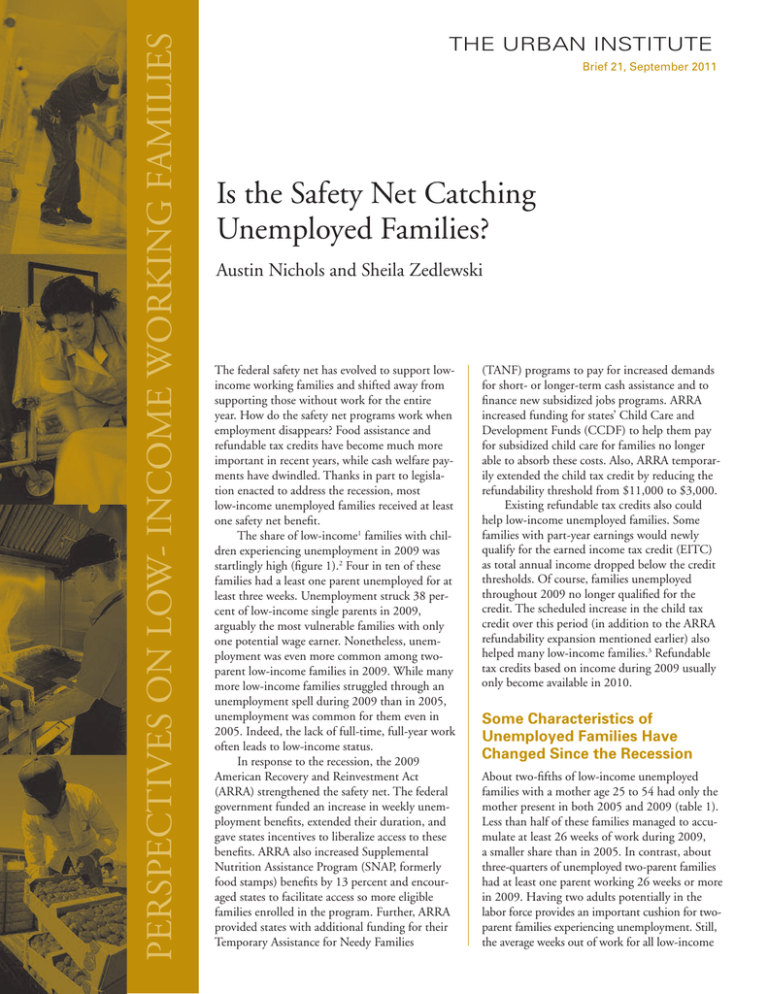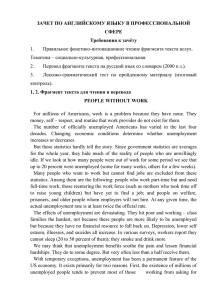Is the Safety Net Catching Unemployed Families? THE URBAN INSTITUTE
advertisement

PERSPECTIVES ON LOW- INCOME WORKING FAMILIES Of the 9.7 million uninsured parents in the United States, as many as 3.5 million living below the federal poverty level could readily be made eligible for Medicaid under current law. THE URBAN INSTITUTE Brief 21, September 2011 Is the Safety Net Catching Unemployed Families? Austin Nichols and Sheila Zedlewski The federal safety net has evolved to support lowincome working families and shifted away from supporting those without work for the entire year. How do the safety net programs work when employment disappears? Food assistance and refundable tax credits have become much more important in recent years, while cash welfare payments have dwindled. Thanks in part to legislation enacted to address the recession, most low-income unemployed families received at least one safety net benefit. The share of low-income1 families with children experiencing unemployment in 2009 was startlingly high (figure 1).2 Four in ten of these families had a least one parent unemployed for at least three weeks. Unemployment struck 38 percent of low-income single parents in 2009, arguably the most vulnerable families with only one potential wage earner. Nonetheless, unemployment was even more common among twoparent low-income families in 2009. While many more low-income families struggled through an unemployment spell during 2009 than in 2005, unemployment was common for them even in 2005. Indeed, the lack of full-time, full-year work often leads to low-income status. In response to the recession, the 2009 American Recovery and Reinvestment Act (ARRA) strengthened the safety net. The federal government funded an increase in weekly unemployment benefits, extended their duration, and gave states incentives to liberalize access to these benefits. ARRA also increased Supplemental Nutrition Assistance Program (SNAP, formerly food stamps) benefits by 13 percent and encouraged states to facilitate access so more eligible families enrolled in the program. Further, ARRA provided states with additional funding for their Temporary Assistance for Needy Families (TANF) programs to pay for increased demands for short- or longer-term cash assistance and to finance new subsidized jobs programs. ARRA increased funding for states’ Child Care and Development Funds (CCDF) to help them pay for subsidized child care for families no longer able to absorb these costs. Also, ARRA temporarily extended the child tax credit by reducing the refundability threshold from $11,000 to $3,000. Existing refundable tax credits also could help low-income unemployed families. Some families with part-year earnings would newly qualify for the earned income tax credit (EITC) as total annual income dropped below the credit thresholds. Of course, families unemployed throughout 2009 no longer qualified for the credit. The scheduled increase in the child tax credit over this period (in addition to the ARRA refundability expansion mentioned earlier) also helped many low-income families.3 Refundable tax credits based on income during 2009 usually only become available in 2010. Some Characteristics of Unemployed Families Have Changed Since the Recession About two-fifths of low-income unemployed families with a mother age 25 to 54 had only the mother present in both 2005 and 2009 (table 1). Less than half of these families managed to accumulate at least 26 weeks of work during 2009, a smaller share than in 2005. In contrast, about three-quarters of unemployed two-parent families had at least one parent working 26 weeks or more in 2009. Having two adults potentially in the labor force provides an important cushion for twoparent families experiencing unemployment. Still, the average weeks out of work for all low-income An Urban Institute Program to Assess Changing Social Policies FIGURE 1. Unemployment Lasting Three or More Weeks by Family Status, 2005 and 2009 (percent) 45 40 2005 2009 35 Unemployment 30 25 20 15 10 5 0 All One parent Two parents Source: Authors’ tabulations of the 2004 and 2008 Surveys of Income and Program Participation. Note: Sample restricted to low-income (below 200% FPL) families with children in which at least one parent is unemployed for three or more weeks during the year and the mother is age 25–54. 2 An Urban Institute Program to Assess Changing Social Policies TABLE 1. Characteristics of Mothers in Low-Income Families with at Least One Parent Unemployed at Least Three Weeks (percent, except where noted) 2005 Work and family structure Low work, 1 adult More work, 1 adult Low work, 2 adults More work, 2 adults Education Less than high school High school Some college College degree Household income Under 50% FPL 50–100% FPL 100–150% FPL 150–200% FPL Race/ethnicity White non-Hispanic Black non-Hispanic Hispanic Other Age 25–29 30–39 40–54 Average weeks unemployed Average income ($2009) 2009 20.4 24.7 9.3 45.6 21.8 19.2 12.1 46.9 20.6 35.2 36.9 7.4 18.0 35.4 36.1 10.6 20.4 24.8 27.3 27.5 19.7 28.8 27.6 23.9 38.9 25.4 30.2 5.6 42.0 20.0 31.0 7.2 21.2 45.9 32.9 15 21,370 22.0 45.8 32.3 21 20,200 Source: Authors’ tabulations of the 2004 and 2008 Surveys of Income and Program Participation. Notes: Sample restricted to low-income (below 200% FPL) families with children in which at least one parent is unemployed for three or more weeks during the year and the mother is age 25–54. Low work is at least one parent working less than 26 weeks during the year. unemployed families increased from 15 weeks in 2005 to 21 weeks in 2009. The recession increased the proportion of more-educated parents out of work. Over 10 percent of mothers experiencing unemployment in 2009 held a college degree, compared with 7 percent in 2005. Nonetheless, parents with a high school education or less bore the brunt of unemployment both in 2009 and 2005; over half of unemployed parents in both years had a high school education or less. The race/ethnicity distribution among unemployed low-income families also shifted. Blacks made up a smaller portion of the unemployed in 2009 than in 2005 (20 versus 25 percent). Whites and those in the other race/ethnicity category made up larger shares of the unemployed in 2009. Unemployed low-income families also had somewhat less income in 2009 than in 2005. Nearly half (49 percent) had incomes below the federal poverty level compared with 45 percent in 2005. Fewer families had incomes between 150 and 200 percent of the poverty level in 2009 than in 2005 (24 compared with 28 percent). Average, inflation-adjusted income for unemployed families dropped by $1,170 between 2005 and 2009. More Families Received Unemployment and SNAP Benefits Many aspects of the safety net responded to high levels and long unemployment durations in 2009. Since the safety net becomes most important to families with limited earnings, we examine benefits received by families with low work (less than 26 weeks during the year) and families with more work (26 or more weeks during the year). 3 An Urban Institute Program to Assess Changing Social Policies Receipt of unemployment insurance (UI) benefits doubled among the low-work unemployed families (37 percent in 2009 compared with 18 percent in 2005, as shown in table 2). The increase reflects expansion of these benefits under ARRA, but also some shift in the characteristics of unemployed families. Those with more education and higher prior earnings are more likely to qualify for these benefits. Relatively few low-work unemployed families turned to cash welfare benefits in 2009 even though many did not receive unemployment benefits. Rates of public assistance (mostly TANF) receipt among all unemployed families with children actually declined for both low-work and more-work families. For example, 24 percent of low-work unemployed families received public assistance in 2009 compared with 29 percent in 2005. Receipt of public assistance declined among single, low-work parents but increased among their two-parent counterparts between 2005 and 2009. The declines in public assistance receipt likely stem from longer-term trends of lower take-up rates and tougher enrollment procedures in many states (Zedlewski and Golden 2010). They also reflect higher receipt of unemployment benefits. Unemployment benefits generally far exceed public assistance benefits, and families with unemployment benefits would not also qualify for public assistance in most states. However, given that about two-thirds of unemployed families with children did not receive unemployment benefits, it is surprising that so few received public assistance. The fraction of families receiving SNAP was higher in 2009 than in 2005. Most of the increase occurred among unemployed families with more work (39 percent in 2005 compared with 47 percent in 2009). Families with less than 26 weeks of work frequently received SNAP in 2005 and 2009. The increase in enrollment among higherwork families could reflect the decline in their income (from $26,270 in 2005 to $24,525 in 2009), but also broader acceptance of this support among working families. Other safety net assistance also helped support unemployed families. In both 2005 and 2009, about half of low-work and three-quarters of more-work families received the EITC. Receipt of the refundable child tax credit jumped in 2009 compared with 2005, reflecting the increase in the per child credit and the ARRA expansion in refundability. Child care assistance declined somewhat during this period and may reflect limited state child care funds relative to increasing demand. Finally, the majority of unemployed families had at least one family member enrolled in Medicaid in both 2005 and 2009. About half of two-parent, low-work unemployed families qualified for unemployment benefits compared with less than a third of single parents in 2009 (table 3). Correspondingly relatively few (18 percent) two-parent, lowwork families received public assistance compared with 28 percent of single-parent families. The 5 percentage point increase in public assistance receipt for two-parent families between 2005 and 2009 contrasts sharply with the 8 point decline for single parents. While more single- and two-parent families received SNAP in 2009 than in 2005, the increases for these low-work unemployed families were relatively small. In 2009, nearly 52 percent of two-parent families received SNAP, compared TABLE 2. Unemployed Families’ Safety Net Benefit Receipt (percent, except where noted) Benefit receipt Unemployment insurance Public assistance SNAP Earned income tax credit Refundable child tax credit Child care assistance Any Medicaid coverage Average weeks unemployed Average family income ($2009) Low work, 2005 Low work, 2009 More work, 2005 More work, 2009 All 2005 All 2009 18.0 29.1 71.8 54.5 2.5 10.8 87.2 19 $9,780 37.4 24.1 72.8 46.8 24.8 9.8 88.6 26 $11,780 22.6 10.7 39.2 76.7 37.2 10.4 72.3 13 $26,270 29.9 8.3 47.0 74.5 63.6 6.9 75.1 19 $24,525 21.2 16.1 48.9 70.1 26.9 10.5 76.7 15 $21,370 32.5 13.6 55.7 65.1 50.4 7.9 79.7 21 $20,200 Source: Authors’ tabulations from the 2004 and 2008 Surveys of Income and Program Participation. Notes: Sample restricted to low-income (below 200% FPL) families with children in which at least one parent is unemployed for three or more weeks during the year and the mother is age 25–54. Low work is at least one parent working less than 26 weeks during the year. Tax estimates are based on 2009 income (received in 2010) and calculated using Taxsim. 4 An Urban Institute Program to Assess Changing Social Policies TABLE 3. Low-Work Unemployed Families’ Safety Net Benefit Receipt by Family Status (percent, except where noted) One-Parent Low-Work Families Unemployment Insurance Public assistance SNAP Earned income tax credit Refundable child tax credit Any Medicaid coverage Child care assistance Average weeks unemployed Average family income ($2009) Two-Parent Low-Work Families 2005 2009 2005 2009 14.0 36.4 81.8 60.1 1.7 92.5 15.5 19 $7,995 30.7 27.5 84.5 51.5 29.7 93.8 12.2 26 $9,540 26.7 12.9 49.5 42.1 4.2 75.7 0.5 18 $13,710 49.5 18.0 51.7 38.4 16.0 79.1 5.5 25 $15,820 Source: Authors’ tabulations of the 2004 and 2008 Surveys of Income and Program Participation. Notes: Sample restricted to low-income (below 200% FPL) families with children in which at least one parent is unemployed for three or more weeks during the year and the mother is age 25–54. Low work is at least one parent working less than 26 weeks during the year. Tax credits are based on 2009 income (received in 2010) and calculated using Taxsim. only SNAP, nearly 40 percent combined SNAP with either unemployment benefits or public assistance. Another 5 percent got help from all three programs during the year. As expected, families in the higher work category received less help from the safety net. About 15 percent of these families received unemployment benefits alone and 28 percent received only SNAP. Just 12 percent received unemployment and SNAP, 5 percent received public assistance and SNAP, and 2 percent received all three benefits. Relatively few single parents got by on unemployment benefits alone (6 percent of lowwork and 3 percent of more-work families). with 85 percent of single-parent families. Higher receipt among low-work single-parent families likely reflects their much lower average incomes ($9,540 compared with $15,820 for two-parent families). Most Families Received at Least One Key Benefit, but Some Got by without Help Some unemployed families, especially those with limited work, received more than one key safety net benefit in 2009 (table 4). While 12 percent of low-work unemployed families received only unemployment benefits and 29 percent received TABLE 4. Unemployed Family Receipt of Multiple Safety Net Benefits, 2009 (percent) All Families One benefit UI only SNAP only Two benefits UI and SNAP PA and SNAP All three benefits (UI, PA, SNAP) No benefits One-Parent Families Two-Parent Families Low work More work Low work More work Low work More work 12.1 28.8 15.4 27.9 6.4 37.3 3.2 42.4 22.2 13.7 20.4 22.0 20.4 18.8 4.7 14.7 11.9 5.1 2.0 36.5 19.8 23.0 4.5 9.0 11.0 10.8 3.7 28.5 21.7 11.4 5.0 24.4 12.3 2.7 1.3 39.7 Source: Authors’ calculations from the 2004 and 2008 Surveys of Income and Program Participation. Notes: Sample restricted to low-income (below 200% FPL) families with children in which at least one parent is unemployed for three or more weeks during the year and the mother is age 25–54. Low work is at least one parent working less than 26 weeks during the year, and high work is at least one parent working 26 weeks or more during the year. 5 An Urban Institute Program to Assess Changing Social Policies Another 20 percent of low-work and 11 percent of more-work single-parent families combined unemployment with SNAP, and relatively few received all three benefits. Two-parent unemployed families more often received only unemployment benefits (22 percent for low work and 20 percent for more work). Two-parent families received SNAP much less often than single-parent families, whether alone or in combination with other benefits. (But, as shown above, SNAP receipt rates for two-parent families increased substantially between 2005 and 2009.) While the vast majority of unemployed families received some help from core safety net programs in 2009, some got by without this help. About 15 percent of all low-work families received no help in 2009, including almost a quarter of low-work two-parent families. The lack of any help from unemployment, SNAP, or public assistance rose to 40 percent among higherworking two-parent families and 29 percent among higher-working single-parent families. Summary and Implications The strength of the safety net during 2009 presents a cup half full, cup half empty story. Among unemployed families with less than 26 weeks of work, 37 percent received unemployment benefits. Receipt was double that observed among similar families in 2005. During the same period, the average duration of unemployment increased from 19 to 26 weeks. The increase in unemployment benefit receipt likely reflects increased eligibility due to expansions in states’ unemployment insurance programs and the federal emergency benefit expansions. Benefit extensions to 99 weeks meant that some families unemployed in 2008 could continue this assistance in 2009. Public assistance played a limited role in unemployed families’ lives in 2009. Among lowwork, unemployed single-parent families, public assistance receipt declined from 36 percent in 2005 to 28 percent in 2009. During the same period, receipt of public assistance increased among two-parent, low-work families (from 13 to 18 percent). The increase in unemployment benefits helps explain relatively low rates of public assistance receipt since few families qualify for both simultaneously. Also, low rates of receipt reflect long-term declining trends in participation among single parents and state TANF program rules that often discourage families from enrolling in welfare. Enrollment in SNAP increased over the 2005 to 2009 period, and most of the increase 6 occurred among unemployed families with children with higher incomes and more work. Higher enrollment rates among these families reflect a drop in income, higher benefits as a result of ARRA, and program outreach likely drawing more working families to this safety net program. Many low-income unemployed families also received the EITC since they had some earnings during the year. Some of these families likely became eligible as a result of reduced earnings in 2009. A dramatically larger share received a refundable child tax credit in 2009 than in 2005, as a result of the ARRA extension of refundability to lower-income taxpayers. The story of how the safety net catches families with children that experience unemployment and low incomes will continue to evolve. Unemployment rates remained stubbornly high throughout 2010 and so far in 2011. The federal extensions of unemployment benefits continued through 2011, but the extension beyond this period was eliminated in the debt ceiling legislation. The effect of the onetime ARRA increase in SNAP benefits has diminished over time, and ARRA money for TANF programs ended in 2010. States are still strapped for cash. Some have scaled back public assistance through cuts to TANF benefits, shorter time limits, and fewer noncash supports (Schott and Pavetti 2011). Some states are restricting unemployment benefits by cutting weeks of eligibility, reducing weekly benefit amounts, and discouraging enrollment (McKenna and Wentworth 2011). Finally, the expansion of the child tax credit is scheduled to expire at the end of 2012, returning to a $500 credit and much lower levels of refundability. The safety net works best when parents are working; earnings, even low earnings, combined with the EITC, SNAP, and child care subsidies often provide the only way out of poverty. Policies that reduce unemployment by growing the economy and training low-income adults for the jobs of the future must be a high priority. Until we see such policies enacted and played out, lowincome families will need to rely on the safety net for help. Federal help to strengthen unemployment insurance, public assistance, and SNAP will be critical. Data Note Data are drawn from the 2004 and 2008 Surveys of Income Program Participation, for all months in the 2005 and 2009 calendar years. Low income An Urban Institute Program to Assess Changing Social Policies is defined as household cash income less than twice the federal poverty level; other definitions are for nuclear families (mothers and minor children, with married partners or biological fathers included when they are present). Low work is defined as under 26 weeks per adult, and more work is at least 26 weeks per adult, with at most two adults present per family. Unemployment is defined as anyone in a family spending at least three weeks searching for a job. Tabulations are weighted to be representative of mothers age 25 to 54. 3. The child tax credit was increased as a result of the Economic Growth and Tax Relief Reconciliation Act of 2001 (EGTRRA). EGTRRA expanded refundability for families with less than three children and phased in an increase in the credit from $500 in 2001 to $1,000 by 2010. Notes Schott, Liz, and LaDonna Pavetti. 2011. “Many States Cutting TANF Benefits.” Washington, DC: Center on Budget and Policy Priorities. 1. Low income is defined as cash family income below twice the official federal poverty level (FPL). 2. This brief focuses on 2009, the most recent full year of data available from the Survey of Income and Program Participation (SIPP). References McKenna, Claire, and George Wentworth. 2011. “Unraveling the Unemployment Insurance Lifeline.” New York: National Employment Law Project. Zedlewski, Sheila, and Olivia Golden. 2010. “Next Steps for Temporary Assistance for Needy Families.” Perspectives on Low-Income Working Families Brief 11. Washington, DC: The Urban Institute. 7 THE URBAN INSTITUTE Nonprofit Org. US Postage PAID Easton, MD Permit No. 8098 2100 M Street, NW Washington, DC 20037-1231 Return Service Requested To download this document, visit our web site, http://www.urban.org. For media inquiries, please contact publicaffairs@urban.org. This brief is part of the Urban Institute’s Low-Income Working Families project, a multiyear effort that focuses on the private- and public-sector contexts for families’ success or failure. Both contexts offer opportunities for better helping families meet their needs. The Low-Income Working Families project is currently supported by The Annie E. Casey Foundation. THE URBAN INSTITUTE 2100 M Street, NW Washington, DC 20037 Copyright © 2011 Phone: 202-833-7200 Fax: 202-467-5775 E-mail: pubs@urban.org The views expressed are those of the authors and do not necessarily reflect those of the Urban Institute, its boards, its sponsors, or other authors in the series. Permission is granted for reproduction of this document with attribution to the Urban Institute. Melissa Hinton, an MPP candidate at Johns Hopkins University, contributed importantly to this brief.






